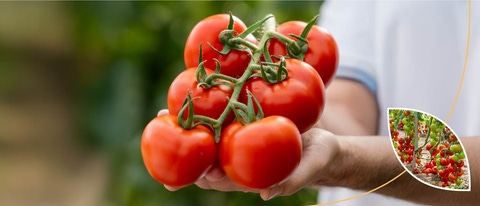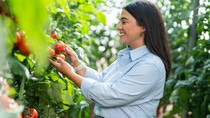Media
The tomato – an economic crown jewel
An interview with Cindy van Rijswijck, Senior Analyst Fresh Produce at Rabobank.
Tomatoes have always been one of the world’s most important crops. At BASF | Nunhems, we are committed to doing more than supplying high quality seeds. We constantly want to gain knowledge and insights by connecting with experts from all disciplines in this dynamic business.
Cindy is such an expert. She and her team closely follow international horticulture markets and regularly share insights on opportunities and challenges growers all over the world face. In this conversation, she reflects on key themes shaping the future of tomatoes, including labor, automation and climate change.
After all these years of reporting on it, what is your view on the tomato industry?
Cindy: “The Rabobank Horticulture Barometer has shown and continues to show a solid 7/10 for this industry over the last years. Major events like the pandemic, spike in energy costs and the Rugose virus only caused that number to drop temporary and relatively little. Even when the bank prepared for the worst scenarios, the industry always got back on its feet relatively quickly.”

Even when we prepared for much worse scenario’s, the industry always got back on their feet relatively quickly.
What are the main challenges the industry will face, according to you?
Cindy: “The demand and – lack of – supply in labor is a recurring theme in agriculture. Several factors contribute to those labor shortages. In the past, working in agriculture was more popular and children would more often take over their parents’ businesses. In the Netherlands there are still successors available but as companies have become very large, a lot of capital is required to buy them, making it more complicated, also for family members.
To compensate for the lack of local workers, growers employed people from other countries. But in recent years, the lack of housing facilities has made that more difficult. And for the next few years, political and social developments will make that more complicated. And then there’s the issue of disappearing knowledge. With less people working in agriculture and many professionals getting ready to retire, much hands-on growing knowledge will disappear. In the future, automation can offer a helping hand in both scenarios, but it is not a truly viable alternative yet.”
Automation, AI, Machine learning are words we keep hearing, but what is their current role or contribution?
Cindy: “In the future, these could help growers to manage larger areas or manage greenhouses remotely and do so with less people involved. For now, we mostly see developments that support management decision making. There are several methods to gather data, analyze it, present it in dashboards and/or use it to train systems predict the growing process. AI and machine already play an important role in optimizing energy usage, but we have yet to see systems that control greenhouse fully autonomously.
And then there’s the robots, which currently have their limitations. Most of these emulate human actions, which presents a range of challenges and limitations. We think that a more radical system innovation might give a better result than the incremental innovations currently applied with robots. But radical innovation requires more capital and a very different way of working which is complicated for growers who are used to work in certain ways. There are a few systems already that have been developed from the ground up with autonomy as a starting point. They look very promising, but also need to be finetuned.”
Climate change could very well pose a bigger challenge for certain growers.
What could the impact of climate change mean for the business?
Cindy: “It could very well pose a bigger challenge for certain growers than for others. Growers in southern parts of Europe, especially those with less advanced greenhouse systems, may suffer from increasingly extreme weather, draughts, rainfall and increased disease pressure, more than their northern European colleagues. Northern European growers with heated glasshouses have to deal with another issue, reducing their climate impact caused by fossil fuel use.”
How do you think tomatoes and the business will evolve?
Cindy: “The tomatoes of the future are both predictable and sustainable. They need to be consistent in volume and quality and be produced sustainably. The systems with a low carbon footprint as well as labor use should be the systems of the future. In these greenhouses, growers would also use water circulation systems and substrates more often. With these they save on resources and prevent issues like leaking of fertilizers into the soil and surface water. To name but a few examples.”
If the past is any indication, the future is looking bright.
Looking at these themes and the history of the tomato business, what do you think the future will look like?
Cindy: “Tomatoes have been popular in the past and, apart from small market shifts and changes, they very much still are today. All signs point to them staying a solid consumer favorite. We do see changes in the type of tomatoes consumed, but growers have been adapting to these trends as well. For many years, there was a trend towards consumption of smaller snacking tomatoes. In the future we might see a revival of very tasty beef tomatoes for all kind of dishes. The type of tomatoes grown, does also depend on growers’ costs and abilities. Picking snack tomatoes has become expensive for example, resulting in a move of production toward low-cost countries. If a proper working robot will be developed, that might change again.
But we also must be pragmatic: just like any other part of the worldwide economy, the tomato business has had and will continue to face its challenges.
Fortunately, from what we’ve seen, tomato growers have a remarkable ability to learn from changes and adapt to them. The response to the ToBRFV outbreak is a great example. The increased hygiene measures help prevent other issues too
Labor and climate change seem the most likely challenges on the horizon. Automation and improved greenhouses can help mitigate the consequences, as long these areas of expertise can keep evolving at a pace that helps growers keep up with the changes they may face.
Whatever happens next in and around the tomato industry; if the past is any indication of what to expect and when this market will stay as resilient as it has been, that future is looking bright.“
Get in touch with us
Please leave your contact details below our get in touch with our experts if you are interested in learning more about our offerings.

